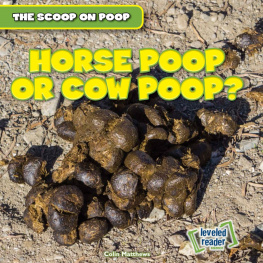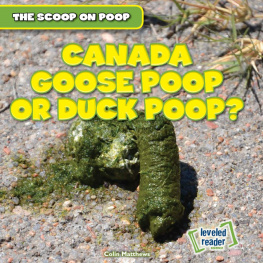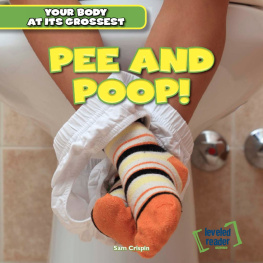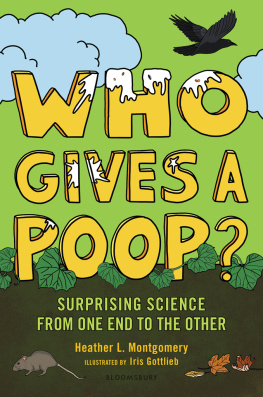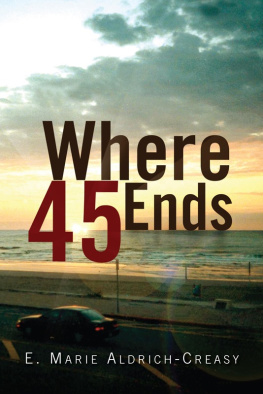Table of Contents
CREATING
SAND BEAC H ES
WITH
POOP
Anita Louise McCormick
10 1 W. 23rd Str eet
Suite 0
New Y ork , NY 10011
USA
enslo w.com
Enslow
P
ublishing
THE
Power
OF POOP
Titles in the series
Visit enslow.com for more information!
One of the amazing things poop can do is create beautiful white sandy beaches.
Scientists have discovered that around 70 percent of white sand found on
beaches comes from parrot fish poop. Parrot fish have bird-like beaks that can
bite off pieces of coral. They chew the coral into tiny particles, digest the algae
that grows on it, and poop out what they no longer needstreams of white coral
sand. Learn about the value of poop in creating beaches, as well as the important
role parrot fish play in the ecological system they live in.
CREATING SAND BEACHES WITH POOP
THE OF P P
Power Power
How Fish and Other Sea Creatures
Make Beaches with Their Poop
ENSLOW
McCormick
Anita Louise McCormick
101 W. 23rd Str eet
Suite
New Y ork, NY 1001 1
USA
enslow.c om
Enslow
P
ublishing
THE OF P P
Power Power
CREATING
SAND BEAC H ES
WITH
POOP
Words to Know
algae Simple plant-like organisms that make food from sunlight but
do not have leaves, roots, or stems.
coral bleaching Coral that has become white because the algae
that once lived inside it has died. Global warming is a major cause.
coral polyp A tiny animal that is related to jellysh and can live as
a single creature or in large colonies.
coral reef Living organisms that are made up of polyps and algae.
Coral reefs live in tropical and semitropical oceans.
ecosystem The plants, animals, and other organisms that live in an
area and interact with each other.
erosion The process of land or beaches being worn down by natural
forces, such as wind, water, or ice.
nutrient Any substance that provides nourishment for plants or
animals.
sandbar An offshore ridge of sand that can be under or partially
above the water level.
sand dunes Ridges or hills of sand that are created by the wind
blowing sand into piles.
storm waves Powerful ocean waves that are driven by strong
winds of hurricanes and other storms.
Contents
Beautiful White Fish Poop ...................................
What Kind of Fish Poops Sand? .......................
Biting Off Coral, Pooping Sand .......................
What Are Coral Reefs? ...........................................
Spreading the Poop Around ............................
Eating, Pooping, and Sleeping
in Mucus Bags ..........................................................
Who Else Is Pooping Sand? ...............................
Fighting Beach Erosion .......................................
Learn More ....................................................................
Index ..................................................................................
Beautiful White
Fish Poop
Imagine you are visiting a beautiful beach in the
tropics. The blue sky touches the ocean, and
white sand stretches as far as you can see. Its
a great place to visit and play. You might take a
walk, collect seashells, build a sand castle, or play
with a beach ball.
But have you
ever wondered
what beautiful
white sandy
beaches are made
of? In some parts
of the world, sand
is composed of
many things, such
as fragments of
rock and shells.
A single parrot fish can poop
an average of 840 pounds of
sand per year!
FUN FACT
Parrot sh come in many different sizes and colors. This
greenthroat parrot sh lives in the Red Sea, near Sudan,
Africa.
Parrot sh mouths are not only colorful but can also break
hard coral into bite-sized pieces. This is a smile that helps
create beautiful beaches.
But the lovely white sand on tropical
and semitropical beaches is made up
almost entirely of sh poop!
While many ocean animals
contribute, parrot sh are by far the
most prolic sand poopers. Scientists
estimate that tropical and semitropical
beaches are made of more than 70
percent parrot sh poop!
Parrot sh get their name not only
because of their bright parrot-like
colors but also because they have large
front teeth that are fused together and
resemble a birds beak. This beak is
strong enough to bite pieces of hard
coral so they can eat the
algae that grow
on it. Their digestive system grinds the
coral into tiny pieces. Then parrot sh
poop out streams of beautiful white
sand as they swim away in search of
their next meal.
What Kind of
Fish Poops Sand?
The ocean is lled with many kinds of sh. Some
sh are so tiny that you can barely see them.
Other sh are very large. All sh eat, digest their
food, and poop whatever they cant digest into
the ocean. But only parrot sh are known for
pooping sand!
Worldwide,
there are more
than 60 species of
parrot sh. The
smaller members
of the species
grow to about 12
inches long, but
the largest can
grow up to four
feet. Parrot sh
Parrot fish get their name for
their beak, the visible teeth
they use to crunch coral.
FUN FACT
Parrot sh enjoy a meal of coral. Before long, they will
digest the algae it contains and poop out streams of sand.
live in coral reefs . They can be found chomping
coral in tropical and semitropical waters around
the world, including the Hawaiian coral reefs,
Australias Great Barrier Reef, and the Caribbean
coral reefs.
A bumphead parrot sh develops a lump on top of its head
when it becomes an adult. The bump helps it break up coral.
FUN FACT
Most parrot sh
are very colorful.
But some kinds
of parrot sh
are not brightly
colored at all.
Bumphead parrot
sh, also known
as humphead
parrot sh, are a
dark greenish gray.
Adult bumphead parrot sh have a big lump on
the front of their head. They use this lump to ram
into coral, which breaks it into smaller pieces that
are easier to eat.
Some people might not think that bumphead
parrot shswimming through the ocean with
huge teeth, a big lump on their head, and banging
into coral reefsare very attractive. But they
poop out more beautiful sand per year that than
any creature in the ocean!
The bumphead parrot fish is the
largest member of the species.





